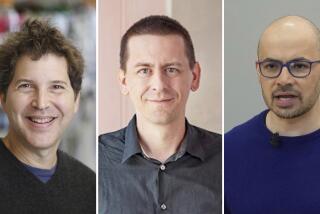Herbert Hauptman dies at 94; won Nobel Prize in chemistry

- Share via
Herbert Hauptman, who won the Nobel Prize in chemistry in 1985 for work uncovering the structure of molecules that accelerated medical research and led to the development of new drugs, has died. He was 94.
His death Sunday in Buffalo, N.Y., was announced by the research center there that bears his name: the Hauptman-Woodward Medical Research Institute. Hauptman, who recently had a stroke, had worked into his 90s at the institute, where he was research director and later president.
Hauptman, a mathematician, received the Nobel Prize three decades after setting out to solve a problem that other scientists had given up on: how to determine molecular structures using X-ray crystallography. He shared the prize with chemist Jerome Karle, with whom he developed mathematical equations to interpret the patterns formed by X-rays scattered from crystals.
“All I had to hear was here was a problem that no one could solve. Not even that, but was even impossible to solve on principle,” Hauptman said during a 2008 documentary on his life produced by WNED-TV of Buffalo. “Once I heard that, there was no letting go.”
Born in New York City on Feb. 14, 1917, Hauptman was the eldest of three sons of Israel Hauptman, an Austrian immigrant who worked as a printer, and Leah Rosenfeld. He earned a bachelor’s degree in mathematics from City College of New York in 1937 and a master’s in mathematics at Columbia University in 1939.
In 1947, after serving as a Navy ensign in the Pacific during World War II, he joined the Naval Research Laboratory in Washington, D.C. He completed his doctorate in mathematics from the University of Maryland in 1955.
At the naval lab he teamed up with Karle, a former City College classmate, to investigate molecular structure using mathematics. Most of the work that led to their joint Nobel Prize was conducted between 1950 and 1956.
Their mathematical approach was controversial among chemists and was ignored for years. Its acceptance grew in the 1970s as the introduction of computers made their techniques easier to apply.
The method became indispensable to modern chemistry and the pharmaceutical industry because it allowed scientists to “make three-dimensional representations of drugs so that we understand what they look like in space and can understand how they work,” said Eaton Lattman, chief executive of Hauptman-Woodward. “I don’t think there’s a single pharmaceutical that’s been developed in the last 30 years that hasn’t been studied using derivations of what Dr. Hauptman and his colleagues won the Nobel Prize for.”
Hauptman left the naval facility in 1970 to head the biophysics lab at the Medical Foundation of Buffalo, which specialized in research on endocrinology. It later was renamed the Hauptman-Woodward Medical Research Institute in recognition of Hauptman’s contributions, along with the Woodward family, whose philanthropy supported the work.
He was a professor at the University at Buffalo, a member of the National Academy of Sciences and author of three books.
A violin player, Hauptman loved classical music and, as a hobby, made stained-glass artwork inspired by mathematical shapes. A collection of his work is displayed at Hauptman-Woodward.
Hauptman is survived by his wife, Edith, two daughters and a brother.
More to Read
Start your day right
Sign up for Essential California for the L.A. Times biggest news, features and recommendations in your inbox six days a week.
You may occasionally receive promotional content from the Los Angeles Times.






